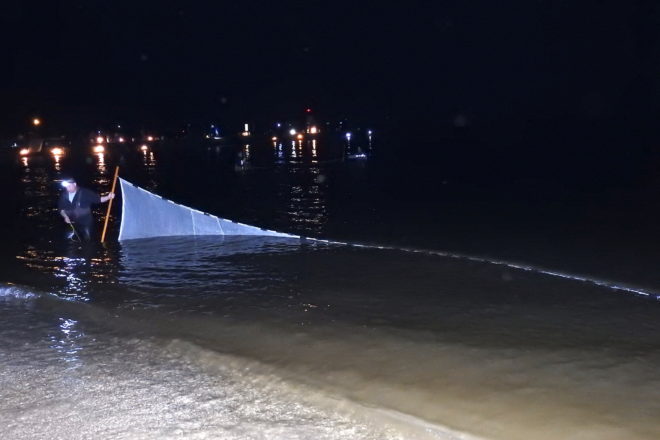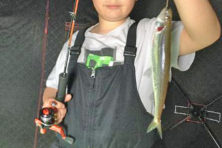2019 Smelt Run Brings Back Memories of ‘Good Old Days’
- Share
- Tweet
- Pin
- Share

One of the best rainbow-smelt runs in years had seasoned smelters scrambling last week to find drop nets, dip nets and seines stored in barns, basements, garages and sheds.
As the word spread by phone, sport-shop talk and social media posts, Kewaunee and Door County piers, creek mouths and bays attracted men, women and children hoping to get enough smelt for one of the tastiest fresh-caught meals available on the Great Lakes.
Smelt spawning runs have always been unpredictable, but especially so during the past two decades as numbers fell from a combination of predation by millions of lake trout and major changes in the lake’s ecosystem brought on by zebra and quagga mussels.
Whether you use a sharp knife or scissors, cleaning smelt is easy, and they’re cooked and eaten bone-in and skin on. The only things you don’t eat are the head and guts, though a stop at Algoma’s south pier last week proved that the decades-long tradition of biting the head off the first smelt of the season is still alive and well with some groups.
Smelt runs were so massive in the 1970s and ’80s that there were nights – and sometimes days, in creeks immediately adjacent to the lake – when you could fill buckets with a single pull of a seine, a carefully lifted drop net or a few swoops of a dip net.
Frozen smelt at times taste fishy, but properly cared for, smelt fresh from the lake are absolutely delicious, whether pan-fried, deep-fried, baked or grilled. Some anglers freeze the larger ones whole for northern pike bait.
With spawn oozing from the bellies of females at Algoma last week, it’s likely the run is over now, but it doesn’t hurt to check – at times Northern Door is a week behind.
If you don’t have a smelt net or seine, plan now for 2020. Who knows? Maybe smelt are making a comeback!
Trout tourney
Wearing a life jacket is the one action that significantly increases the chances of surviving a fall into cold water, giving you a fighting chance to survive the shock, get your head above water and call for help before hypothermia sets in.
Dozens of boaters are already on the water fishing for walleyes, pike and brown trout, and this weekend’s Baileys Harbor Brown Trout Tournament will attract hundreds more.
More than $7,000 in cash and prizes will be awarded to those who catch the top 40 heaviest brown trout off Door and Kewaunee Counties. Weigh-in sites include Baileys 57, Howie’s Tackle, Kap’s Marina and Hooked Up Tackle Shop.
For more details, visit BaileysHarbor.com, email [email protected] or call 920.839.2366.
Deer results
The DNR received more than 9,500 responses during its online input period about County Deer Advisory Council (CDAC) recommendations across the state.
Even though most Door County hunters use just one or two tags each season, they can get five free antlerless tags with each bow or crossbow and gun deer license this fall; Kewaunee County hunters can get four.
Check out the public comments on the Door/Kewaunee CDAC recommendations at dnr.wi.gov/topic/hunt/cdac.html.
For the birds
Arbor Day weekend is a great time to think about planting trees and making landscaping changes to benefit birds and other wildlife. With a little planning, even small yards can provide excellent habitat for birds and butterflies. Adding large planters of hummingbird- and butterfly-friendly flowering plants around your spring and summer feeding stations, for instance, can attract larger numbers of colorful visitors.
One basic idea is to plant progressive heights of plants, with the shortest in the front and the tallest and thickest in the rear, and it’s best to use native flowering plants, trees and shrubs. There are many plans available online, or you can consult with a gardener friend or landscaping professional to get some insights.
If you’re an experienced gardener, perhaps you could share your expertise with a local school. Getting kids educated and interested in wild things can lead to a lifelong love, concern and appreciation for the environment.
Short shots
• Bird migration continues to heat up: the first swallows, purple martins and bluebirds of the season have been spotted, as have Bonaparte’s gulls, loons, caspian terns and many shorebird species. Keep track of the migration south to north at ebird.org/wi. If you haven’t already done so, clean out your bird houses now.
• As of April 19, Lake Michigan was 23 inches above its 100-year average and four inches higher than last year at this time. Water levels were 54 inches above the all-time April low, set in 1964, and only 10 inches below the all-time high, set in 1986.
• The spring Conservation Congress meeting page has been updated with citizen resolutions introduced. Visit dnr.wi.gov/About/WCC/springhearing.html.
• Lake sturgeon are spawning on many river systems, including along the popular Sturgeon Trail on the Wolf River at New London. Shiocton is another great viewing location.


